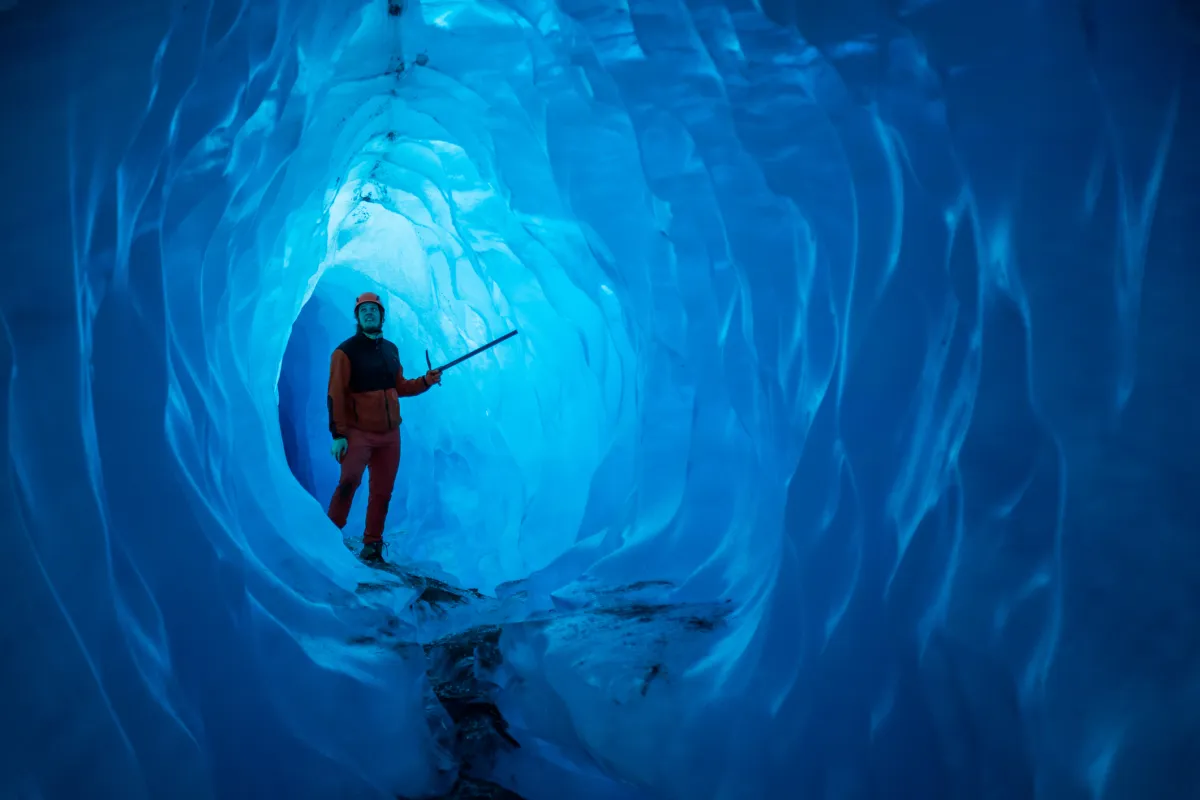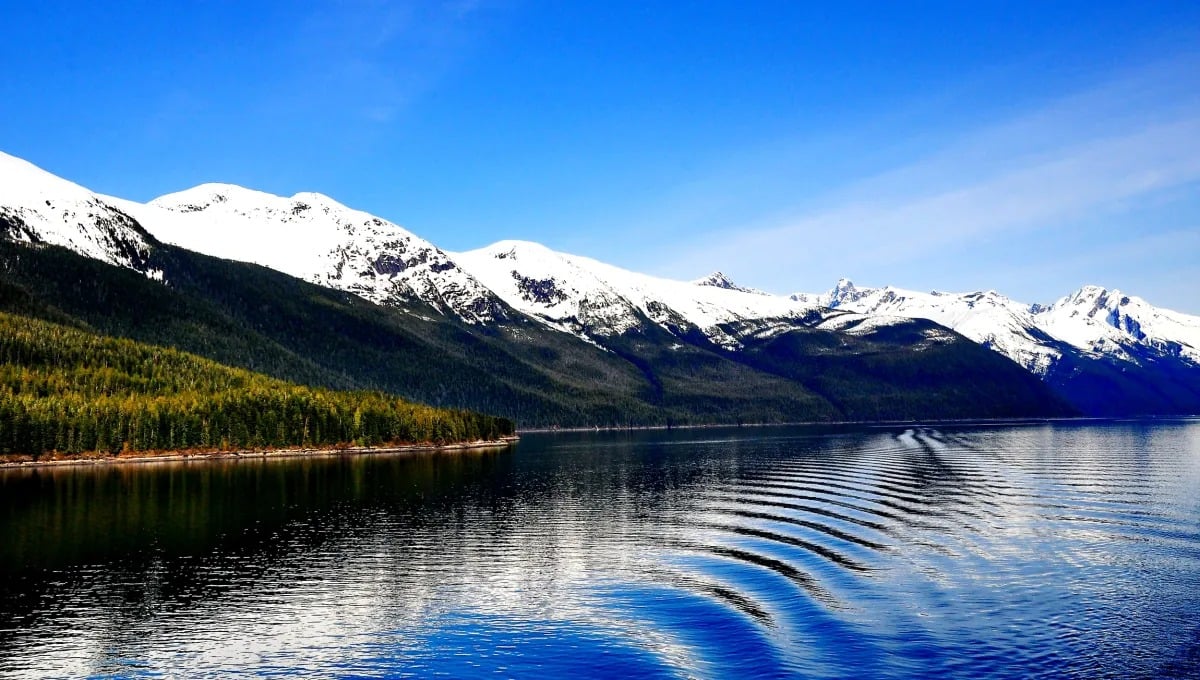
Alaska’s enchanting beauty is unrivaled, and among its plethora of natural wonders, the glaciers stand out as the crowning jewels. One of the few remaining places left where you can easily access these behemoth ice formations, glacier hiking is one of the best ways to experience their power and beauty.
Embarking on a glacier hike should be an integral part of your Alaskan expedition, offering an unmatched blend of adventure and natural beauty. In this guide, we will walk you through the basics of glacier hiking, as well as how to have a safe and fun glacier-adventure on your trip to Alaska.
What is a Glacier?
A glacier is a large mass of ice that forms on land from the accumulation and compaction of snow over a long period. Contrary to first impression, these icy formations are not static but are in a continuous state of motion due to their own weight, constantly moving downhill like slow, frozen rivers.
Alaska is home to over 100,000 glaciers covering about 29,000 square miles, contributing to some of the world's most breathtaking landscapes. Hiking one of these glaciers is not just a scenic experience but a journey through time, as many Alaskan glaciers have been forming for thousands of years.
What is a Guided Glacier Hike?
While the idea of conquering an Alaskan glacier might be alluring, it is vital to note that glacier hiking alone is perilous. Glaciers are complex, constantly evolving landscapes that pose numerous hazards. Crevasses—deep, often hidden cracks in the ice—pose a significant threat. Avalanches, falling ice, unstable terrain, and sudden weather changes also add to the danger.
Glacial environments can be incredibly deceptive, appearing stable when they are constantly opening new dangers and making well-worn paths incredibly treacherous. While glacier hiking is an amazing activity, we suggest going with an experienced guide to ensure that you remain safe on your hike, have the proper gear, and get the best views.
Guided glacier hikes are available across Alaska, offering a safer and more informative way to experience these natural wonders. Guides are experienced professionals who understand glacier dynamics and are trained in rescue techniques.
Here's what you can expect on your first guided glacier hike:
Gear
Your guide will provide you with the essential gear needed for a safe and successful glacier hike. They will also model how to use the gear and give you time to practice. A typical gear kit includes:
- Crampons: These metal devices with spikes attach to your boots and provide necessary traction on the ice.
- Ice Axe: An essential tool for maintaining balance and arresting your slide if you slip.
- Harness and Ropes: These are used to secure you to your guide and other hikers in your group, reducing the risk of a fall into a crevasse.
- Helmet: A vital piece of safety equipment to protect you from falling ice.
- Gaiters: These coverings for your lower legs keep your boots and pants dry.
Terrain
Expect a variety of terrain on your glacier hike. Glaciers are dynamic and ever-changing landscapes, and depending on the time of year and specific glacier, the conditions can differ. The type of hike you chose can also impact your hike. Some hikes may start on top of a glacier after being dropped off by a helicopter, while other tours may depart from a trailhead and venture over rocky moraine before reaching the icy expanse of the glacier itself.
The glacier's surface may be hard ice, soft snow, or a mix of both. You might encounter ice formations such as seracs, crevasses, and moulins. Your guide will help you navigate this terrain safely. Most guides recommend visitors to be in decent athletic condition and only allow older children. Check with your specific guiding service for age restrictions and health concerns (such as injury, pregnancy, or athletic ability).
Sightseeing
Glaciers offer a variety of sights that will leave you awe-struck. You'll witness stunning ice formations in an array of blues, from the palest baby blue to deep sapphire. You might see meltwater streams, glacial pools, and ice caves. On a sunny day, the glacier can sparkle like a diamond field.
Around the glacier, expect to see breathtaking landscapes, including mountains, forests, cascading waterfalls, and perhaps even the ocean, depending on the glacier's location. Wildlife sightings are also possible, including seals, birds, or even bears from a safe distance.
The guide will provide a wealth of information about the glacier's formation, movement, and impact on the surrounding ecosystem. You'll learn about the flora and fauna that inhabit these harsh conditions and get an understanding of the effects of climate change on these ancient ice fields. Another great perk to booking a guided hike!
What to Bring on Your Guided Glacier Hike
While your guiding service will provide the essential gear you will need during the hike, your comfort level will dramatically increase with a few key essentials to bring with you.
Clothing
Glaciers are cold, and the weather can change rapidly, so dressing in layers is key. Here's what you should wear:
- Base Layer: Think thermal underwear, both top, and bottoms. Opt for moisture-wicking and quick-drying materials.
Insulating Layer: This could be a fleece or wool sweater to keep you warm. - Outer Layer: Waterproof and windproof jackets and pants are a must. They'll protect you from wind, rain, and any wetness from the glacier.
Don't forget to pack waterproof gloves, a warm hat that covers your ears, and thick, moisture-wicking socks. A neck gaiter or scarf could also come in handy.
Footwear
Your guide will provide crampons, but you'll need solid hiking boots that are waterproof and have good ankle support. Make sure they're broken in and comfortable for a day of walking.
Backpack Essentials
What goes in your backpack can make or break your glacier hiking experience. Here's a list of items you should consider packing:
- Water: Even in cold weather, staying hydrated is crucial. Aim for at least 2 liters of water, and be sure to top off your bottles before you set off. If you start getting a headache, be sure to check on how much water you are drinking. Dehydration is common out on the ice, and headaches are one of the first signs that your body needs more water.
- Snacks: You'll burn a lot of energy hiking. Bring high-protein snacks like nuts, energy bars, or jerky. While some guides provide snacks, be sure to pack food if you have a specific food allergy or are on a special diet.
- Sunglasses and Sunscreen: Glare from the ice can be intense, so UV protection is essential, even on cloudy days. Be sure to stop and reapply your sunscreen every hour. If you are sweating a lot, apply it more frequently.
- Camera: You'll want to capture the breathtaking scenery, so don’t forget your camera or smartphone. Be sure to pack your camera in a moisture-proof case and ensure that it is protected in your bag in case you fall.
- First Aid Kit: While guides will likely have one, it's good to have a small kit with band-aids, antiseptic wipes, blister pads, and any medications you may need. Also pack a small packet of painkillers, as headaches can be common after a few hours out on the ice.
- Extra Clothes: Pack an extra set of base layers, socks, and gloves. If your clothes get wet, you'll appreciate a dry change for the drive home.
Top Visited Glaciers in Alaska
While glaciers can be found throughout the state, here are some of the most commonly visited and easily accessible glaciers to get you started on planning your adventure:
- Exit Glacier: Part of the Kenai Fjords National Park, this glacier is accessible via road and offers numerous guided hiking opportunities.
- Matanuska Glacier: At 27 miles long and 4 miles wide, Matanuska is the largest glacier accessible by car. It offers amazing guided treks.
- Mendenhall Glacier: Just outside Juneau, this glacier offers incredible views, a visitor center, and various guided adventures.
- Glacier Bay National Park: This park is home to a whopping 1000 glaciers and offers a range of guided tours, boat rides, and hikes.
- Portage Glacier: A favorite for its accessibility, the Begich, Boggs Visitor Center offers boat tours and guided hikes.
Read more: Hubbard Glacier vs Glacier Bay

